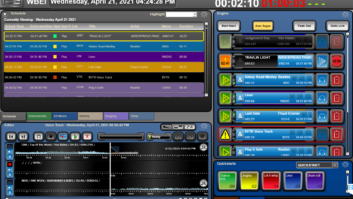I touched briefly on what spares to put aside when you were setting up shop in a new job in our June 2015 issue. This month, I want to elaborate on the RF spares that you should maintain to make your job a bit easier.
THE SPARE TUBE
If you have a vacuum tube transmitter, then clearly you need a spare tube at the transmitter site. And no — that’s not a luxury at all.
The best spare is really a tube that has quite a few hours on it — one that is just getting soft, basically. Why is that? Mainly, it’s because you can be confident that when you put it back in the transmitter (say in an emergency or during troubleshooting) that it’ll work fine.
New tubes sometimes have little problems that don’t show up until they’ve run for a while. The idea here is to have a known good device that instills confidence, so that you can rest easy after closing the transmitter door and heading home.
Let the soft spare gain some extra hours while you wait for a replacement’s delivery.
EXCITERS AND POWER AMPLIFIERS
If you take care of multiple FM transmitter sites, then it makes sense to get your hands on a spare exciter that is frequency-agile so that it can be used anywhere.
Usually older generation exciters, such as the Continental 802A, the BE FX-30 (or 50) or the Harris MX-15 make good candidates for on-the-shelf spares. If you really want to be ready for emergencies, then take the time to figure out the frequency-determining dipswitch settings for your spare exciter, so that in the heat of the moment, with a station off the air, you don’t have to think too much. Somewhere inside, record the settings for each possible FM frequency in your group, and try them out, so there are no surprises in the middle of the night.
If your transmitter uses a solid-state IPA then by all means obtain a spare. Don’t fool yourself into thinking that you’ll simply fix a dead one in the middle of the night with a soldering iron, solder wick and some new devices. The best after-hours fix is one that takes the least amount of time.
STL RECEIVERS AND TRANSMITTERS
If you have a group of stations, each with a different 950 MHz band channel, then it makes sense to have frequency-agile spares on the shelf.
Good candidates for spares are the Mosely 606 transmitter (the 606 receiver is crystal-controlled and not frequency-agile) or any of the 6000-series receivers and transmitters.
Again, in preparation for your inevitable need, take the time to figure out the frequency determining dipswitch settings for each of your devices, put them on paper and keep that paper inside the unit itself. That way you won’t need to do much thinking in the event you need to install one of these devices in a hurry.
RPU RECEIVERS
The RPU receiver probably doesn’t qualify as something you’d need to replace in the middle of the night, but in the event that you have an “extra,” give it a test, and put it on the shelf after you know it works correctly.
If you do a lot of RPU remotes (especially on weekends) then having a ready spare is a good way to save yourself some time on what would normally be a day off in the event a receiver dies right before your morning show guy takes the mic at the local car dealership.
WHAT SPARE PARTS TO KEEP?
Often times you will find collections of spare parts at a transmitter site, along with collections of resistors, capacitors and whatnot. Are any of these boxes of things worth keeping? Well, that depends on the situation of course.
Transmitter parts for a transmitter no longer in the building. Very common to find tons of what are essentially obsolete parts. You may check with your engineering buddies and see if they might have a need before you e-waste them.
Resistors and solid-state devices. Neither resistors nor solid-state devices spoil on the shelf, so they’re probably worth keeping.
Capacitor kits. Electrolytic capacitors age and dry out, so unless you are sure they’re relatively young, I would toss them.
Think of all these projects as investments in time that will pay off later, when you don’t have to stress over an impromptu middle-of-the-night repair job. It’ll make your life easier — and don’t forget to let your colleagues, especially the boss, know that you planned ahead and minimized station down-time.
Irwin is RF engineer/project manager for iHeartMedia Los Angeles. Contact him at doug@dougirwin.net.






